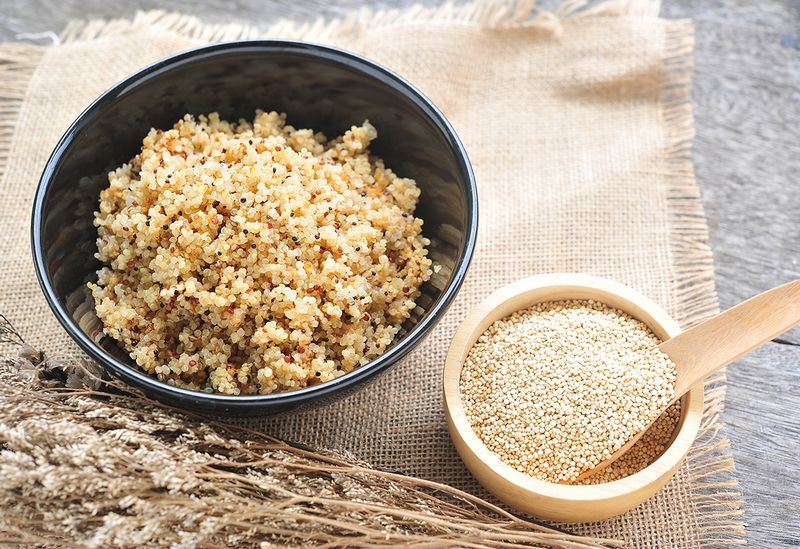
Exploring the Marvels of Quinoa: Unlocking the Potential of an Age-old Grain in Contemporary Cuisine
In the world of modern cooking, where new food trends and ingredients constantly emerge, one ancient grain has stood the test of time – quinoa. With a rich history dating back thousands of years, quinoa has become a staple in many modern kitchens due to its versatility and numerous health benefits.
Quinoa, pronounced “keen-wah,” was first cultivated by the Incas in the Andes mountains of South America. This ancient grain was highly valued for its nutritional properties and was often referred to as the “mother of all grains.” Today, quinoa continues to be celebrated for its high protein content, essential amino acids, and abundance of vitamins and minerals.
One of the wonders of quinoa lies in its adaptability to various cooking methods and flavors. Whether you’re looking to create a hearty salad, a comforting bowl of porridge, or a flavorful side dish, quinoa can be easily incorporated into any recipe. Its mild, nutty taste pairs well with both sweet and savory ingredients, making it a versatile grain for modern cooks.
Moreover, quinoa’s cooking time is relatively short compared to other grains, making it a convenient option for those with busy schedules. In just 15 minutes, quinoa can be cooked to perfection, resulting in a fluffy texture and a satisfying meal. Its quick cooking time and ability to absorb flavors make quinoa an ideal choice for those seeking healthy and delicious meals in a short amount of time.
In conclusion, quinoa is truly a wonder of the culinary world. Its ancient origins, modern versatility, and numerous health benefits make it a valuable addition to any kitchen. Whether you’re a seasoned chef or a novice cook, quinoa is sure to inspire you with its endless possibilities for creating delicious and nutritious meals.
The History of Quinoa
Quinoa, a versatile and nutritious grain, has a long and fascinating history. This ancient grain has been cultivated and consumed for thousands of years, dating back to the time of the Inca civilization in the Andean region of South America. The Incas considered quinoa to be a sacred crop, and it played a crucial role in their diet and culture.
Quinoa was highly valued by the Incas for its nutritional properties and ability to grow in harsh conditions. It was known as the “mother grain” and was often used as a staple food. The Incas believed that quinoa gave them strength and endurance, and it was even used in religious ceremonies.
Despite its long history, quinoa remained relatively unknown outside of the Andean region until recent years. In the modern era, quinoa has gained popularity for its health benefits and versatility in cooking. It is now recognized as a superfood and is enjoyed by people all over the world.
Quinoa is not only packed with nutrients, but it is also gluten-free and easy to digest. It is rich in protein, fiber, vitamins, and minerals, making it an excellent choice for a balanced and nutritious diet. Its mild and nutty flavor makes it a great addition to a variety of dishes, from salads and soups to stir-fries and desserts.
Today, quinoa is cultivated in many countries, including the United States, Canada, and several European countries. It is grown both for domestic consumption and for export, contributing to the economic development of these regions. The ancient grain has truly stood the test of time and continues to be a staple in modern cooking.
Nutritional Benefits of Quinoa
Quinoa, a modern grain, has gained popularity in recent years due to its numerous nutritional benefits. This ancient grain is a powerhouse of nutrients and is a great addition to any diet.
One of the wonders of quinoa is its high protein content. Unlike other grains, quinoa is a complete protein, meaning it contains all nine essential amino acids that the body needs. This makes it an excellent choice for vegetarians and vegans looking to increase their protein intake.
In addition to protein, quinoa is also rich in fiber. Fiber is essential for maintaining a healthy digestive system and can help prevent constipation. The high fiber content of quinoa also helps to regulate blood sugar levels and can aid in weight management.
Quinoa is also a good source of vitamins and minerals. It is particularly high in magnesium, which is important for maintaining healthy bones and muscles. It also contains iron, which is essential for transporting oxygen throughout the body, and potassium, which is important for maintaining a healthy heart.
Another benefit of quinoa is its versatility in cooking. It can be used in a variety of dishes, from salads and soups to main courses and desserts. Its nutty flavor and fluffy texture make it a delicious and satisfying addition to any meal.
In conclusion, quinoa is a modern grain that offers a range of nutritional benefits. Its high protein and fiber content, along with its vitamins and minerals, make it a valuable addition to any diet. Whether you’re looking to increase your protein intake, improve your digestion, or simply enjoy a delicious and versatile grain, quinoa is a wonderful choice for modern cooking.
Quinoa as a Complete Protein Source
Quinoa, an ancient grain, has gained popularity in modern cooking due to its numerous health benefits. One of the wonders of quinoa is its ability to serve as a complete protein source.
A complete protein source is one that contains all nine essential amino acids that the body needs to function properly. Quinoa stands out among other grains as it contains all nine essential amino acids, making it an excellent choice for vegetarians and vegans who may struggle to get enough protein from plant-based sources.
Not only is quinoa a complete protein, but it is also packed with other essential nutrients. It is a good source of fiber, iron, magnesium, and phosphorus. This makes it a nutritious and filling grain that can be incorporated into a variety of dishes.
Quinoa’s versatility in cooking is another reason why it has become so popular. It can be used as a base for salads, added to soups and stews, or even used as a substitute for rice or pasta. Its mild, nutty flavor pairs well with a wide range of ingredients, allowing for endless possibilities in the kitchen.
In conclusion, quinoa’s status as a complete protein source, along with its nutritional content and versatility in cooking, make it a valuable addition to any diet. Whether you are vegetarian, vegan, or simply looking to incorporate more nutritious grains into your meals, quinoa is a great choice to consider.
Quinoa’s Role in a Gluten-Free Diet
Quinoa, the ancient grain known for its numerous health benefits and versatility in cooking, plays a crucial role in a gluten-free diet. Gluten, a protein found in wheat, barley, and rye, can cause digestive issues and allergic reactions in individuals with gluten sensitivity or celiac disease. Quinoa, being naturally gluten-free, provides a nutritious alternative for those following a gluten-free diet.
Quinoa is a complete protein, meaning it contains all nine essential amino acids that the body needs for proper functioning. This makes it an excellent choice for individuals who need to avoid gluten but still want to meet their protein requirements. Additionally, quinoa is rich in fiber, vitamins, and minerals, making it a nutritious addition to any meal.
When it comes to cooking, quinoa offers endless possibilities for gluten-free recipes. It can be used as a substitute for rice or pasta, added to salads for extra texture and flavor, or used as a base for gluten-free grain bowls. Its mild and nutty taste makes it a versatile ingredient that pairs well with a variety of flavors.
For individuals with gluten intolerance or celiac disease, quinoa provides a safe and nutritious alternative to gluten-containing grains. By incorporating quinoa into their diet, they can still enjoy the wonders of cooking with a grain while maintaining a gluten-free lifestyle.
Cooking with Quinoa: Versatile and Easy
Quinoa is an ancient grain that has gained popularity in modern cooking. It is known for its versatility and ease of preparation, making it a favorite ingredient for many home cooks.
One of the wonders of quinoa is its ability to be used in a variety of dishes. It can be cooked and served as a side dish, added to salads for extra protein and texture, or even used as a substitute for rice or pasta in main courses. Its nutty flavor and fluffy texture make it a great addition to both savory and sweet dishes.
Cooking with quinoa is also incredibly easy. It cooks quickly, usually in about 15 minutes, and requires minimal effort. Simply rinse the quinoa, add it to a pot with water or broth, and bring it to a boil. Once boiling, reduce the heat and let it simmer until the liquid is absorbed and the quinoa is tender. It can be flavored with herbs, spices, or even cooked with vegetables and proteins for added flavor.
In addition to its versatility and ease of preparation, quinoa is also a nutritious grain. It is packed with protein, fiber, and essential nutrients, making it a healthy choice for any meal. It is also gluten-free, making it a great option for those with dietary restrictions or sensitivities.
In conclusion, cooking with quinoa is a wonderful way to add a nutritious and versatile ingredient to your meals. Whether you’re looking for a side dish, a main course, or a healthy snack, quinoa is sure to satisfy. Give it a try and discover the wonders of this ancient grain in your modern cooking.
Quinoa Salads: Refreshing and Satisfying
When it comes to cooking with quinoa, there are endless possibilities. One of the most popular ways to enjoy this ancient grain is in salads. Quinoa salads are not only delicious, but they are also refreshing and satisfying.
What makes quinoa salads so wonderful is the versatility of this grain. Quinoa can be paired with a variety of ingredients to create a unique and flavorful salad. From fresh vegetables to fruits, nuts, and herbs, the options are endless.
Quinoa is known for its nutty flavor and delicate texture, which makes it an excellent base for salads. It adds a satisfying crunch and a subtle nuttiness to any dish. Plus, quinoa is packed with protein, fiber, and essential nutrients, making it a healthy choice for any meal.
Whether you’re looking for a light and refreshing salad for lunch or a hearty and satisfying option for dinner, quinoa salads are the perfect choice. They can be enjoyed as a main course or as a side dish, and they are sure to please even the pickiest eaters.
So why not give quinoa salads a try? With their ancient origins and modern appeal, they are a delicious and nutritious addition to any meal.
Quinoa as a Substitute for Rice and Pasta
Quinoa, a modern grain, has become a popular choice for those looking to add variety to their cooking. With its nutty flavor and versatile texture, quinoa can easily be used as a substitute for rice and pasta in a variety of dishes.
One of the wonders of quinoa is its ability to absorb flavors, making it an excellent base for a wide range of cuisines. Whether you’re making a stir-fry, curry, or pilaf, quinoa can be cooked and seasoned to complement any dish. Its light and fluffy texture adds a satisfying element to meals, making it a great alternative to traditional rice or pasta.
Quinoa is also a nutritious option for those looking to incorporate more whole grains into their diet. Unlike refined grains like white rice and pasta, quinoa is a complete protein, meaning it contains all nine essential amino acids. It is also high in fiber and packed with vitamins and minerals, making it a healthy choice for any meal.
When cooking with quinoa, it’s important to note that it has a slightly different cooking method than rice or pasta. Quinoa should be rinsed thoroughly before cooking to remove any bitterness. It is then cooked in a 2:1 ratio of water to quinoa, similar to rice. Once cooked, it can be used as a base for salads, soups, or served as a side dish.
In conclusion, quinoa is a modern grain that offers a world of possibilities in the kitchen. Its versatility, nutty flavor, and nutritional benefits make it an excellent substitute for rice and pasta. Whether you’re looking to add more variety to your meals or boost your nutritional intake, quinoa is a fantastic choice for any modern cook.
Quinoa in Baked Goods: Adding a Healthy Twist

Quinoa, an ancient grain with numerous health benefits, is not just limited to savory dishes. It can also be incorporated into baked goods, adding a healthy twist to your favorite recipes. With its nutty flavor and unique texture, quinoa can elevate the taste and nutritional value of your baked goods.
When using quinoa in baked goods, it is important to cook it properly beforehand. This ensures that the quinoa is tender and adds the desired texture to your final product. You can cook quinoa by boiling it in water or broth until the grains are fluffy and translucent. Once cooked, you can let it cool before incorporating it into your favorite baking recipes.
Quinoa can be used in a variety of baked goods, such as breads, muffins, cookies, and cakes. It can be added to the batter or dough, providing an extra layer of flavor and nutrition. You can also sprinkle cooked quinoa on top of breads and muffins for added crunch.
In addition to its taste and texture, quinoa is also a great source of protein, fiber, and essential nutrients. By incorporating quinoa into your baked goods, you can increase the nutritional value of your treats without sacrificing taste. This makes it a perfect choice for those looking to add a healthy twist to their baking.
So why not give quinoa a try in your next baking adventure? Whether you’re making a batch of cookies or a loaf of bread, quinoa can be a versatile and nutritious addition. Experiment with different recipes and enjoy the wonders of this ancient grain in your baked goods.
Quinoa Breakfast Ideas: Starting the Day Right
When it comes to starting the day off right, quinoa is a modern grain that offers a multitude of breakfast options. This ancient wonder grain is not only nutritious but also versatile, making it an excellent choice for breakfast cooking.
One popular quinoa breakfast idea is to make a warm and comforting quinoa porridge. Simply cook quinoa in milk or water and add your favorite toppings, such as fresh fruits, nuts, or honey. The creamy texture and nutty flavor of quinoa make it a delicious and satisfying way to begin your day.
For a quick and easy breakfast, try making quinoa breakfast bars. Mix cooked quinoa with mashed bananas, eggs, and a touch of honey. Bake the mixture in a pan until golden brown and cut into bars. These portable breakfast bars are perfect for those busy mornings when you need a nutritious meal on the go.
If you prefer a savory breakfast, quinoa can be used to make a delicious and protein-packed quinoa scramble. Sauté cooked quinoa with vegetables like spinach, bell peppers, and onions. Add spices like turmeric and cumin for extra flavor. Top with a fried egg and avocado for a hearty and satisfying breakfast option.
Another creative way to incorporate quinoa into your breakfast routine is by making quinoa pancakes. Blend cooked quinoa with eggs, milk, and your choice of sweetener. Cook the batter on a griddle until golden brown and serve with your favorite toppings, such as maple syrup or fresh berries. These fluffy and nutritious pancakes are sure to be a hit with the whole family.
Whether you’re looking for a warm and comforting porridge, a quick and convenient breakfast bar, a savory scramble, or fluffy pancakes, quinoa offers endless possibilities for starting your day off right. Its versatility and nutritional benefits make it a modern grain that is perfect for breakfast cooking.
Quinoa Desserts: Sweet and Nutritious
Quinoa, an ancient grain, has become increasingly popular in modern cooking, and it’s not just limited to savory dishes. Quinoa desserts are a delicious and nutritious way to satisfy your sweet tooth while reaping the benefits of this versatile grain.
One popular quinoa dessert is quinoa pudding. Made with cooked quinoa, milk, sweetener, and spices, this creamy treat is a healthier alternative to traditional rice pudding. The quinoa adds a nutty flavor and a slight chewiness, making it a satisfying dessert option.
Another delightful quinoa dessert is quinoa chocolate cake. This decadent treat combines cooked quinoa, cocoa powder, eggs, and sweetener to create a rich and moist cake. The quinoa adds a unique texture and boosts the nutritional profile of the dessert.
If you’re looking for a lighter option, try quinoa fruit salad. This refreshing dessert combines cooked quinoa with a variety of fresh fruits, such as berries, melons, and citrus. The quinoa adds a protein-packed element to the salad, making it a satisfying and nutritious dessert choice.
For those who prefer a crunchy dessert, quinoa granola bars are the perfect option. Made with quinoa, oats, nuts, dried fruits, and sweetener, these bars are a healthy and portable snack. The quinoa adds a satisfying crunch and a boost of protein and fiber.
As you can see, quinoa desserts offer a wide range of options for those looking to incorporate this ancient grain into their sweet treats. Whether you’re craving something creamy, chocolaty, fruity, or crunchy, there’s a quinoa dessert for everyone. So why not give it a try and discover the wonders of quinoa in your desserts?
Quinoa in International Cuisine
Quinoa, an ancient grain, has gained popularity in modern cooking across the globe. Its versatility and nutritional benefits have made it a staple ingredient in many international cuisines.
In South America, where quinoa originated, it has been a dietary staple for thousands of years. It is commonly used in traditional dishes such as quinoa salad, quinoa soup, and quinoa porridge. The Incas considered quinoa a sacred grain and believed it to be a source of strength and vitality.
In North America, quinoa has become a popular alternative to rice and pasta. It is often used as a base for salads, stir-fries, and grain bowls. Its nutty flavor and fluffy texture make it a delicious and nutritious addition to any meal.
In Europe, quinoa has become a trendy ingredient in various cuisines. It is used in Mediterranean dishes like quinoa tabbouleh and quinoa-stuffed peppers. In Scandinavian countries, quinoa is often mixed with other grains to create hearty and healthy dishes.
Asian cuisines have also embraced quinoa in their culinary traditions. In Japan, quinoa is used in sushi rolls and as a topping for rice bowls. In India, quinoa is cooked with spices and vegetables to create flavorful dishes like quinoa biryani.
Quinoa’s popularity in international cuisine is a testament to its adaptability and nutritional value. Whether you’re looking for a grain-free alternative or simply want to incorporate more whole grains into your diet, quinoa is a versatile and delicious choice.
Quinoa Farming: Sustainable and Environmentally Friendly
Farming quinoa is not only a way to produce a nutritious and versatile grain, but it also offers numerous benefits for the environment. Quinoa farming is known for its sustainability and environmentally friendly practices.
One of the key aspects of quinoa farming is its ability to thrive in diverse climates and soil conditions. This makes it a suitable crop for regions with limited water resources or poor soil quality. By growing quinoa, farmers can make use of land that would otherwise be unsuitable for traditional crops, reducing the need for deforestation or the use of chemical fertilizers.
Furthermore, quinoa farming is known for its low water requirements compared to other crops. This is particularly important in regions where water scarcity is a major concern. By choosing to grow quinoa instead of water-intensive crops, farmers can contribute to the conservation of this precious resource.
Quinoa is also a naturally pest-resistant crop, which means that farmers can avoid the use of harmful pesticides and insecticides. This not only reduces the environmental impact of farming but also ensures that the grain remains free from chemical residues, making it a healthier choice for consumers.
Additionally, quinoa farming often involves crop rotation, which helps to maintain soil fertility and prevent soil erosion. By alternating quinoa with other crops, farmers can replenish nutrients in the soil and minimize the risk of nutrient depletion. This sustainable farming practice promotes long-term soil health and reduces the need for synthetic fertilizers.
In conclusion, quinoa farming is a sustainable and environmentally friendly practice that offers numerous benefits. By choosing to grow this ancient grain, farmers can contribute to the conservation of natural resources, reduce the use of harmful chemicals, and promote soil health. Moreover, consumers can enjoy the nutritional wonders of quinoa while supporting a more sustainable food system.
Quinoa’s Impact on Indigenous Communities
Quinoa, a modern superfood, has had a profound impact on indigenous communities around the world. This ancient grain, once a staple in the diets of the Incas, has gained popularity in recent years for its nutritional benefits and versatility in modern cooking.
For indigenous communities, quinoa has provided economic opportunities and improved food security. As the demand for quinoa has increased, farmers in these communities have been able to sell their crops at higher prices, leading to increased income and improved livelihoods. This has allowed them to invest in education, healthcare, and infrastructure for their communities.
Furthermore, the cultivation of quinoa has helped to preserve indigenous traditions and knowledge. Indigenous farmers have passed down their expertise in growing and harvesting quinoa from generation to generation. This has not only ensured the continuity of their cultural practices but has also allowed them to maintain a strong connection to their ancestral lands.
In addition to its economic and cultural impact, quinoa has also had positive effects on the health and well-being of indigenous communities. This nutrient-rich grain is packed with protein, fiber, and essential vitamins and minerals. Its consumption has been linked to improved cardiovascular health, reduced risk of chronic diseases, and enhanced overall nutrition.
In conclusion, quinoa’s rise as a modern grain has brought numerous wonders to indigenous communities. It has provided economic opportunities, preserved cultural traditions, and improved the health and well-being of those who have cultivated it for centuries. As we continue to appreciate and enjoy quinoa in our modern diets, let us also acknowledge and support the indigenous communities who have stewarded this ancient grain for generations.
Incorporating Quinoa into a Healthy Lifestyle
Quinoa, a modern cooking wonder, has gained popularity in recent years for its numerous health benefits and versatility in the kitchen. This ancient grain is packed with nutrients, making it a great addition to a healthy lifestyle.
One of the best things about quinoa is its high protein content. It contains all nine essential amino acids, making it a complete protein source for vegetarians and vegans. Incorporating quinoa into your diet can help you meet your daily protein needs and promote muscle growth and repair.
Quinoa is also rich in fiber, which is important for a healthy digestive system. It can help prevent constipation and promote regular bowel movements. Additionally, the fiber in quinoa can help you feel fuller for longer, which can aid in weight management and prevent overeating.
Incorporating quinoa into your meals is easy. You can use it as a substitute for rice or pasta in your favorite dishes. Quinoa can be cooked and used in salads, soups, stir-fries, and even desserts. Its nutty flavor and slightly chewy texture add a unique touch to any dish.
To make the most of quinoa’s nutritional benefits, it’s important to cook it properly. Rinse the quinoa thoroughly before cooking to remove any bitterness. Use a ratio of 1 cup quinoa to 2 cups water or broth. Bring to a boil, then reduce the heat and simmer for about 15-20 minutes until the quinoa is tender and the liquid is absorbed.
Overall, incorporating quinoa into a healthy lifestyle is a smart choice. Its nutritional profile, versatility in cooking, and delicious taste make it a perfect addition to any diet. Whether you’re a vegetarian, vegan, or just looking to add more nutrient-rich foods to your meals, quinoa is a grain worth exploring.
FAQ:
What is quinoa?
Quinoa is an ancient grain that has been grown for thousands of years in the Andean region of South America. It is known for its high nutritional value and is often referred to as a superfood.
How do you cook quinoa?
Cooking quinoa is simple. First, rinse the quinoa under cold water to remove any bitterness. Then, combine one part quinoa with two parts water or broth in a saucepan. Bring to a boil, then reduce the heat and simmer for about 15 minutes or until the liquid is absorbed. Fluff with a fork and it’s ready to serve.
What are the health benefits of quinoa?
Quinoa is packed with nutrients. It is a good source of protein, fiber, and various vitamins and minerals. It is also gluten-free, making it a great option for people with gluten intolerance or celiac disease. Quinoa is also known to be high in antioxidants and has been linked to various health benefits, including improved blood sugar control and reduced risk of heart disease.
Can quinoa be used in different types of dishes?
Yes, quinoa is incredibly versatile and can be used in a variety of dishes. It can be used as a substitute for rice or pasta, added to salads, used as a filling for stuffed vegetables, or even used in baking. Its mild, nutty flavor makes it a great addition to both savory and sweet dishes.





